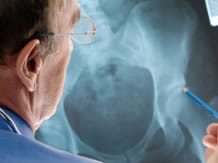
It is likely that in the early stages, damage to the cartilage might be completely reversible, thanks to the healing capacities of the lesions, especially in the very young.
Once these lesions become significantly established and especially after a certain age, it will be difficult for the body to repair these lesions, osteoarthritis will then evolve to a worsening stage which means that there will be an increasingly greater loss of cartilage.
This loss of cartilage evolves in 3 clinical forms:
- a slow and progressive deterioration over several decades;
- or, conversely, a very rapid deterioration leading to loss of cartilage in 12 to 24 months (this is known as rapidly destructive osteoarthritis;
- or an intermediate form in which the evolution is punctuated by periods in which the osteoarthritis evolves very quickly and other periods, on the contrary, when the osteoarthritis does not evolve or evolves very little.
Osteoarthritis does not evolve uniformly, it is unpredictable. It can remain silent for a long time and not manifest itself even though the joint looks very damaged on the X-ray. But it can also worsen rapidly over several weeks or months at a stage when the X-rays are almost normal. It is this imbalance between pain and radiographic osteoarthritis which makes it difficult to understand and evaluate.
Why this imbalance?
Osteoarthritic flare-ups reflect structural changes and destruction of the cartilage surface, with the production of debris.
At first, the thickness of the cartilage is preserved and X-rays are normal. The debris and degradative enzymes released are very irritating to the joints. As a result the latter manufacture a larger amount of synovial fluid (which normally exists in small quantities) to enable diluting irritant substances and lubricate the damaged joint.
During an osteoarthritic flare-up these lesions persist and worsen if the joint is left untreated and/or not rested either completely or partially (using a cane to relieve weight bearing joints).
In this case, the cartilage no longer having its normal resistance, irritant substances continue their action of cartilage degradation and the slow healing process cannot be completed properly. The painful flare-up continues.
By resting your joints during an osteoarthritic flare-up (combined or not with a treatment), they can finally "self cleanse" and heal: the cartilage regains its firm surface. Although it is thin on the X-rays, it ensures its normal function. After a few days of treatment and/or rest, you can thus resume your normal activities.
The evolution is thus a succession of painful flare-ups separated by intervals of variable duration, up to the stage of cartilage ulceration. At this stage, the cartilage has disappeared and part of the bone is exposed so the pain may intensify. Sometimes the episodes slow down or even disappear, replaced by pain proportional to the time of walking and standing.
Sometimes as much as twenty years may go by between the beginning of the first flare and the total destruction of the cartilage.
However, the pain caused during osteoarthritic flare-ups is not always very pronounced, so that some people neglect their osteoarthritis with the risk of it being discovered at an advanced stage.
Thus, you need to know that it is not normal to suffer regularly from a painful joint. It is essential that you go and see your doctor as early as possible.
He or she will decide, if considered necessary, to prescribe standard X-rays which will be used for regular monitoring.
How do the radiological signs evolve?
Generally, radiological lesions gradually and slowly increase. However, the pace of this progression can be very variable. In extreme cases, some cases of osteoarthritis may remain stable for decades, while others progress very rapidly to complete destruction of the cartilage in the space of a few months. It is difficult if not impossible today to predict how fast the evolution of your osteoarthritis will be.
In addition, the evolution of pain and lack of joint mobility is not always proportional to the size of the lesions.



















